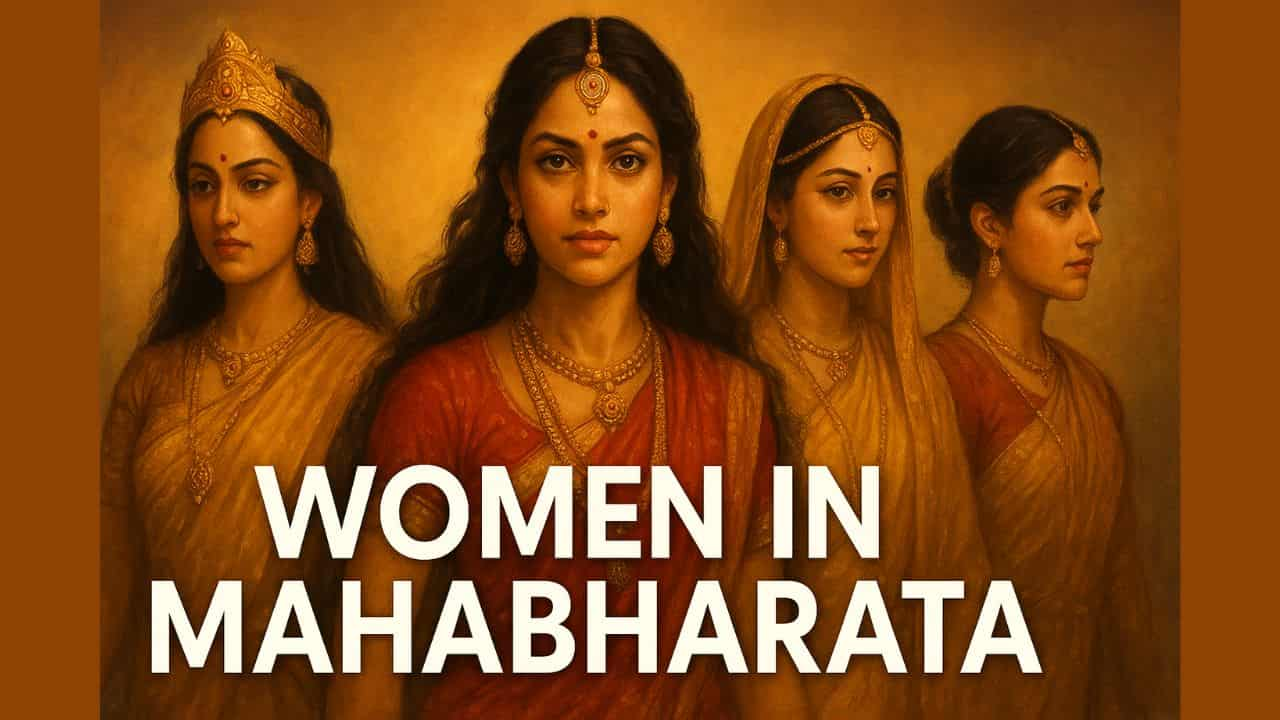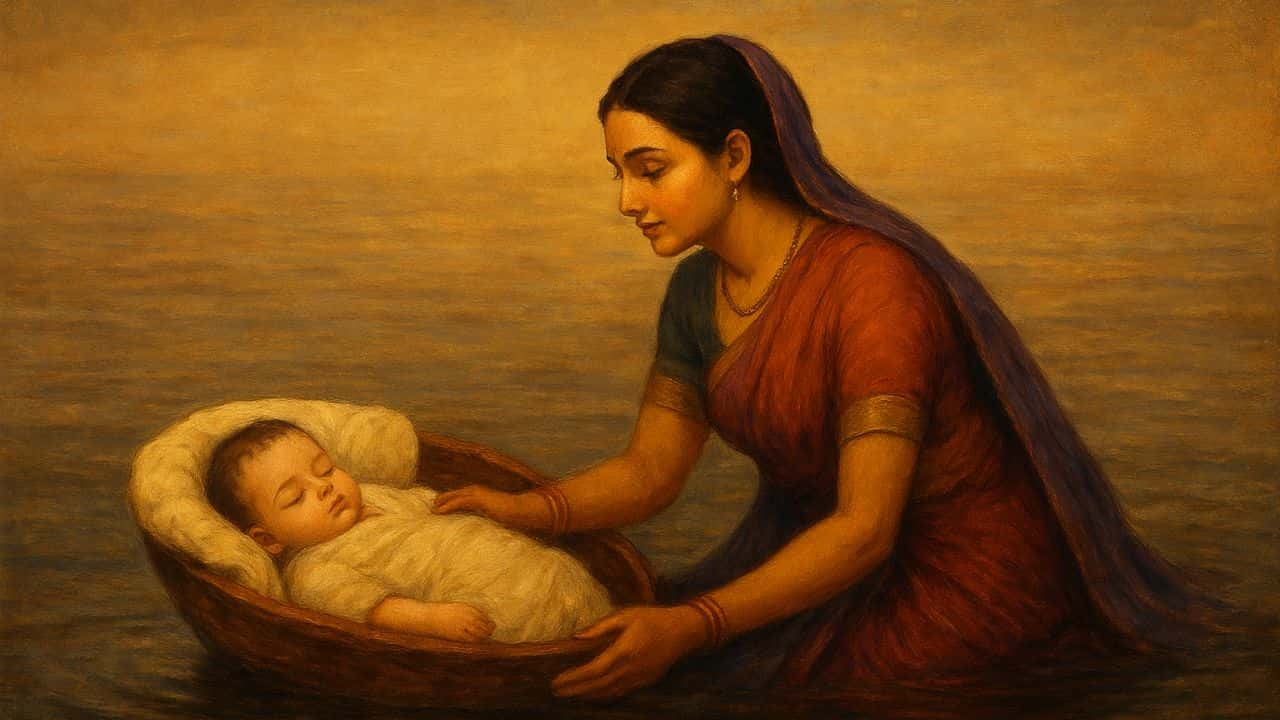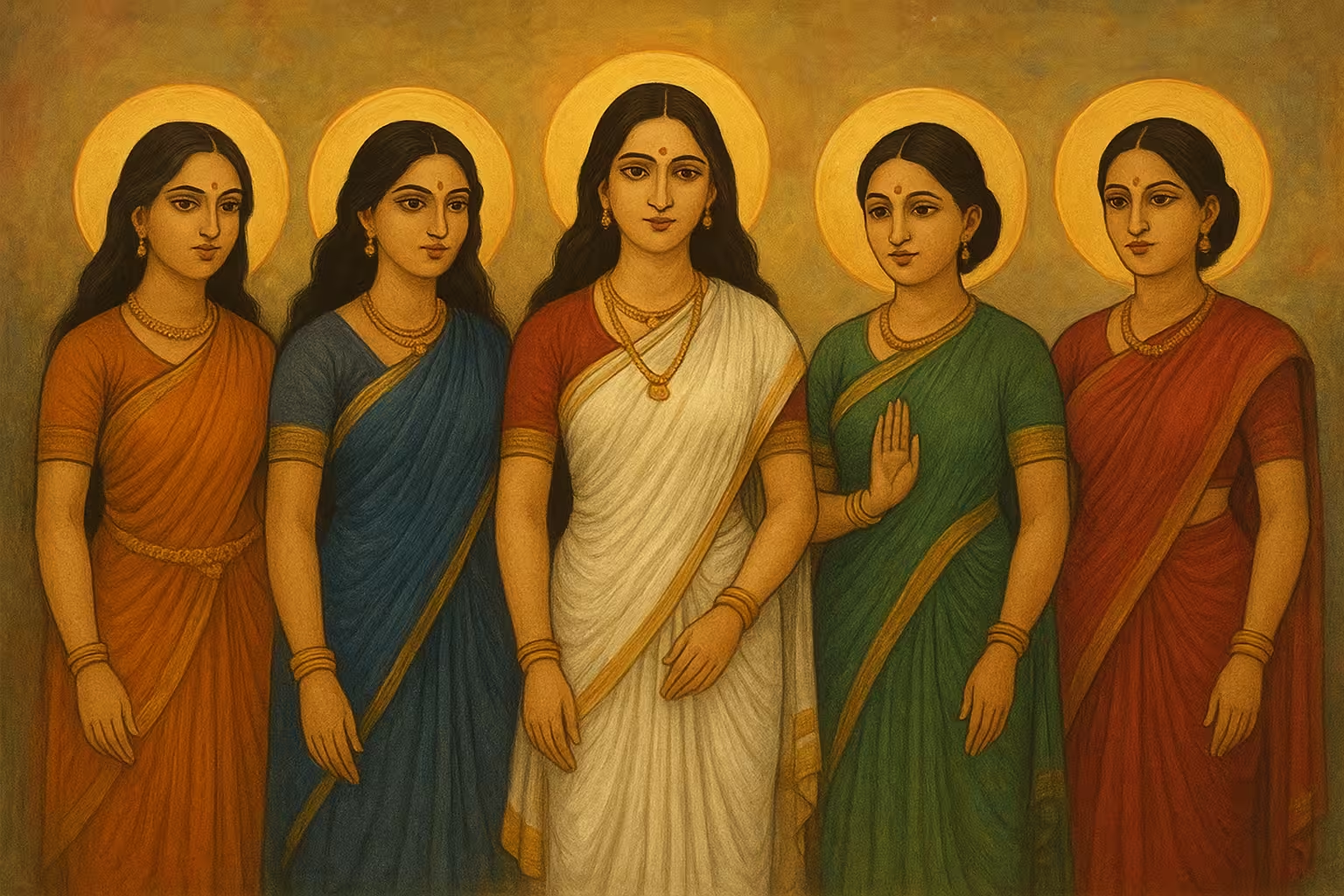Women in an Epic of War and Dharma

The Mahabharata, one of the greatest epics of world literature, is often remembered for its heroes, Arjuna’s valor, Bhishma’s vows, and Krishna’s divine guidance.
Yet, beneath the thunder of battles and the clash of kingdoms lies another narrative, quieter but equally powerful: the stories of women of the Mahabharata.
The women of the Mahabharata were not silent spectators but active agents of destiny. They endured sacrifice, wielded influence, and carried strength in a world dominated by men. Their stories illuminate the struggles of living in a patriarchal society while revealing timeless lessons about resilience and power.
1.Kunti: The Mother Who Bore the Weight of Secrets

Kunti, the mother of the Pandavas, embodies both sacrifice and silent suffering. Gifted with a boon to summon gods, she bore Karna, the son of Surya, before her marriage.
Fear of social disgrace forced her to abandon the infant, a decision that haunted her throughout her life. Later, she used the same boon to bring forth the Pandavas, each from a different deity, ensuring the continuation of her lineage.
But Kunti’s role was far more than that of a mother. She was a political strategist, guiding her sons in times of peril and ensuring their survival in a hostile world.
Yet she lived with the torment of hiding the truth about Karna, watching him fight against his brothers without ever revealing his identity. Her story is one of unending sacrifice, of love, duty, and the unbearable silence of secrets.
2. Draupadi: Fire Born and Fierce
Draupadi, born of fire, is one of the most complex figures in the Mahabharata.
Married to five husbands, she became the emotional center of the Pandavas’ journey. Her insult at the Kaurava court, where Dushasana attempted to disrobe her, remains one of the most harrowing episodes in the epic. That moment of humiliation sparked the Great War, making her both a victim and a catalyst of change.
Yet Draupadi was not passive in her suffering. She was fiercely intelligent, outspoken, and unwilling to accept injustice. Her demand for vengeance was not born of personal anger alone but from a desire to restore dharma.
Draupadi symbolizes resistance in a patriarchal world, a woman who refused to be silenced, even when surrounded by kings and elders who failed to protect her.
3. Gandhari: Blindfolded Devotion and Silent Protest
Gandhari, the queen of Hastinapur and mother of the Kauravas, chose to blindfold herself upon marriage to Dhritarashtra, who was born blind.
This act has been interpreted both as supreme devotion and as a silent protest against her fate. By willingly embracing blindness, Gandhari lived a life of sacrifice, aligning herself with her husband’s world of darkness.
But Gandhari was also a woman of great moral strength. Though she loved her sons deeply, she recognized their flaws and pleaded with Duryodhana to abandon his arrogance. When her advice was ignored, she stood powerless, watching her lineage descend into destruction. Her curse on Krishna after the war, in which she blames him for not preventing the carnage, demonstrates her moral authority.
Gandhari represents the tragedy of a mother torn between love for her children and adherence to dharma.
Subhadra, Hidimba, and Other Voices Often Forgotten
While Kunti, Draupadi, and Gandhari dominate much of the narrative, other women of the Mahabharata add depth to the epic.
Subhadra, Krishna’s sister and Arjuna’s wife, represents the gentler, stabilizing force of love and family. She raised Abhimanyu, who became one of the war’s greatest young heroes, only to lose him tragically.
Hidimba, the rakshasi who fell in love with Bhima, chose a life of dignity over her clan’s violence. She raised their son Ghatotkacha, who played a vital role in the war.
Then there is Ulupi, the Naga princess who married Arjuna, and Chitrangada, the warrior princess of Manipur, women whose stories remind us that the women of the Mahabharata stretch far beyond Hastinapur into a wider cultural and mythical landscape.
Women of the Mahabharata as Catalysts of Destiny
The Mahabharata is often referred to as an epic of dharma, where choices, moral or immoral, shape the course of one’s destiny.
The women of the Mahabharata often acted as catalysts, their lives deeply intertwined with the fate of kingdoms.
Draupadi’s humiliation set the war in motion. Kunti’s silence about Karna sealed tragic outcomes. Gandhari’s blind love for her sons contributed to their downfall.
Yet these were not mere accidents of fate. The epic shows that women, though bound by social constraints, had the power to influence history in profound ways. They bore the burdens of men’s ambitions, but they also stood as voices of conscience, questioning the very structures of power.
Symbolism of the Women of the Mahabharata
Each of these women of the Mahabharata carries symbolic weight.
Kunti represents duty and the unbearable cost of silence. Draupadi is the fire of resistance, standing against humiliation and injustice. Gandhari embodies sacrifice, devotion, and the tragic consequences of unchecked maternal love. The lesser-known women add shades of independence, courage, and maternal strength.
Collectively, they show that the Mahabharata is not just a story of warriors and kings but also of mothers, wives, and daughters who navigated a world where their agency was constantly tested.
Their struggles reflect the timeless reality of women in patriarchal societies, expected to sacrifice, yet holding immense power in shaping destinies.
Modern Interpretations of the Epic’s Women
Today, the women of the Mahabharata continue to inspire literature, theater, and feminist readings.
Draupadi, for instance, is often seen as an early voice against gender injustice, demanding accountability from the most powerful men of her time. Kunti’s life raises questions about motherhood, secrecy, and social expectations of women. Gandhari’s blindfold has become a metaphor for willful ignorance, sacrifice, and silent endurance.
These stories resonate with modern audiences because they highlight dilemmas still relevant today: the conflict between personal happiness and social duty, the struggle for justice in the face of power, and the resilience of women in male-dominated worlds.
The Timeless Strength of Women in the Mahabharata
The women of the Mahabharata remind us that strength comes in many forms.
It is in Kunti’s resilience, Draupadi’s fiery defiance, Gandhari’s moral authority, and Subhadra’s quiet nurturing. Their lives are layered with contradictions, sacrifice and strength, silence and speech, devotion and resistance.
They were not warriors in the battlefield, but they were warriors of spirit. Their voices continue to echo through centuries, teaching us that power is not only about weapons and thrones but also about endurance, wisdom, and moral courage.
Beyond the Battlefield
When we think of the Mahabharata, it is easy to focus on Kurukshetra’s battlefield. Yet the true essence of the epic lies equally in the stories of its women.
They may have lived in a patriarchal world, but they were not defined by silence alone. They spoke, acted, and suffered in ways that shaped the destiny of kingdoms.
Their stories remind us that history is never just about kings and warriors. It is also about mothers, wives, and daughters whose strength carried societies through triumph and tragedy. The women of the Mahabharata live not only as characters of an epic but as symbols of timeless power, sacrifice, and resilience.

